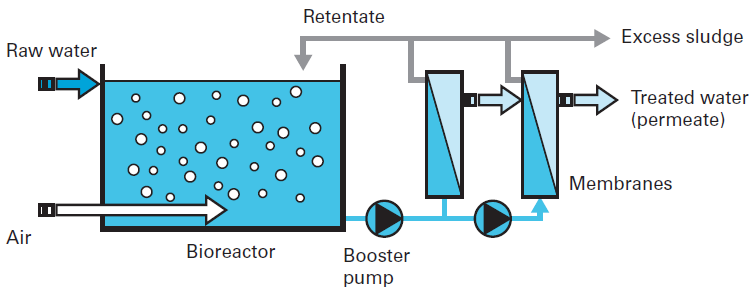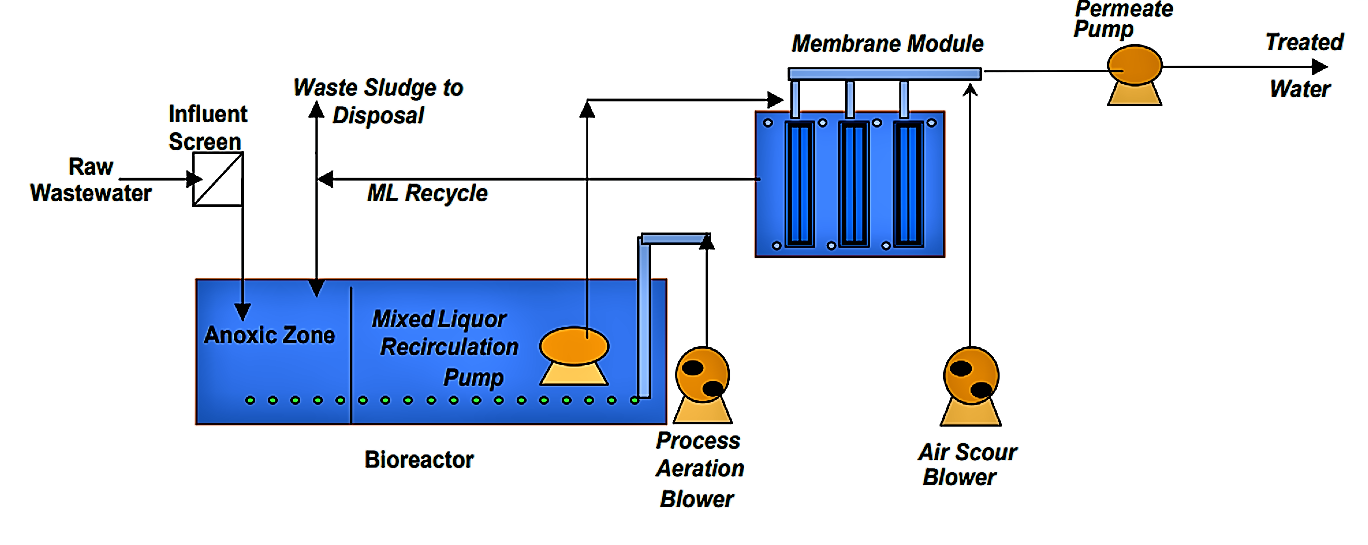Understanding the Basics of Membrane Bioreactor Systems for Wastewater Management
Understanding the Basics of Membrane Bioreactor Systems for Wastewater Management
Blog Article
How Membrane Bioreactors Are Reinventing Water Purification Equipments
The emergence of membrane layer bioreactors (MBRs) stands for a substantial innovation in the area of water filtration, combining organic treatment processes with innovative membrane layer filtering innovations. As global water deficiency heightens, the duty of MBRs in helping with potable water reuse and sustainable water administration becomes significantly vital.
Review of Membrane Layer Bioreactors
Membrane layer bioreactors (MBRs) stand for a substantial improvement in water filtration modern technology, as they incorporate biological therapy procedures with membrane layer filtering. This combination boosts the performance of wastewater therapy by making use of microbes to degrade organic contaminants while simultaneously using semi-permeable membrane layers to separate cured water from suspended microorganisms and solids.
The MBR system typically contains an organic reactor where the microbial population metabolizes pollutants, followed by a membrane layer filtering system that maintains biomass and enables only tidy water to travel through. This dual performance results in greater effluent quality compared to standard therapy methods. MBRs can be run in both batch and continual circulation settings, offering versatility in layout and application.
Additionally, MBRs are identified by their small impact, making them suitable for city settings with room restrictions. Membrane Bioreactor. They also make it possible for the healing of water for reuse, thus adding to water sustainability efforts. While MBR modern technology has actually acquired popularity in community and industrial applications, its functional complexities and power demands demand cautious consideration throughout implementation. Generally, MBRs are at the forefront of boosting water treatment performance and quality, showcasing the possibility for cutting-edge services in environmental monitoring.
Advantages of MBR Innovation
The combination of biological treatment with membrane layer filtering uses various benefits for water purification procedures. Among the primary benefits of Membrane layer Bioreactor (MBR) modern technology is its ability to properly get rid of both not natural and organic pollutants, causing premium effluent. The membranes work as a physical obstacle, stopping suspended solids and virus from going through, which enhances the general safety and security and dependability of cured water.
In addition, MBR systems need a smaller sized footprint compared to standard treatment methods, enabling more reliable space application. This compact design is especially helpful in metropolitan settings where land is restricted. MBRs also demonstrate operational adaptability, accommodating differing influent top qualities and flow prices without significant efficiency destruction.
Additionally, the process supplies improved nutrient elimination capacities, particularly for nitrogen and phosphorus, which are crucial for stopping eutrophication in receiving waters. The decreased sludge production related to MBR innovation likewise converts to reduce disposal costs, making it an economical option in the future - Membrane Bioreactor. Generally, the advantages of MBR technology placement it as a leading option for sustainable and innovative water filtration systems, attending to both environmental and financial issues
Applications in Water Purification
Applications of Membrane Layer Bioreactor (MBR) technology in water filtration are varied and impactful, attending to different treatment needs throughout several markets. MBRs successfully integrate biological therapy processes with membrane layer filtration, making them ideal for municipal wastewater therapy, commercial effluent management, and even potable water reuse efforts.
In municipal settings, MBRs are progressively employed to boost the top quality of dealt with wastewater, enabling conformity with rigorous discharge regulations and promoting the recycling of water for watering and non-potable uses. Their portable style additionally makes them ideal for metropolitan settings where room is limited.
Industrially, MBR technology is utilized to deal with process water and wastewater, especially in industries such as food and beverage, drugs, and textiles. By effectively getting rid of impurities additional resources and put on hold solids, MBRs assist markets minimize ecological influences while recuperating valuable sources from wastewater streams.
Moreover, MBRs are obtaining grip in decentralized water treatment applications, where small-scale systems can be released in remote locations or establishing regions. This flexibility allows areas to attain sustainable water monitoring solutions, boosting accessibility to tidy water while reducing dependence on traditional therapy methods.
Case Studies and Success Stories

In an additional example, a textile manufacturing center in Bangladesh embraced MBR innovation to resolve its wastewater difficulties. The system decreased chemical oxygen demand (COD) levels from 1,200 mg/L to much less than 100 mg/L, hence satisfying regulatory requirements and substantially lessening environmental effect.
The College of Cape Town's MBR setup has actually confirmed effective in dealing with greywater for non-potable reuse on university. This project not just conserves safe and clean water however likewise acts as an academic design for sustainable methods.
In addition, a fish and shellfish processing plant in Norway utilized MBR innovation to deal with effluents containing high levels of natural issue, achieving over 90% toxin removal. These study highlight MBR technology's convenience and try here its essential function in enhancing water top quality across diverse applications.
Future of Water Therapy Solutions
As worldwide water scarcity and air pollution difficulties escalate, cutting-edge water therapy solutions are coming to be significantly necessary to guarantee sustainable accessibility to tidy water. The future of water treatment depends on the assimilation of sophisticated innovations that enhance the performance and performance of purification processes. Membrane layer bioreactors (MBRs) go to the center of this advancement, incorporating biological treatment with membrane layer purification to create top notch effluent ideal for numerous applications.

Arising patterns such as resource healing from wastewater, including nutrients and energy, will certainly additionally change therapy centers right into environmentally friendly hubs. Advancements in nanotechnology and membrane layer products assure improved efficiency and long life of filtration systems.

Conclusion
Their duty in drinkable water reuse and sustainable water monitoring highlights their importance in dealing with worldwide water deficiency challenges. Proceeded research and development will better improve the effectiveness and adoption of MBR modern technology, making sure a resistant future for water therapy solutions.
The development of membrane bioreactors (MBRs) represents a substantial advancement in the area of water purification, merging organic treatment procedures with cutting-edge membrane filtration modern technologies. As worldwide water shortage heightens, the role of MBRs in assisting in safe and clean water reuse and sustainable water administration becomes progressively important. They likewise enable the recovery of water for reuse, thus contributing to water sustainability efforts.As international water deficiency and pollution difficulties increase, innovative water treatment options are becoming progressively essential to make certain lasting access to tidy water. Their role in drinkable water reuse and lasting water monitoring highlights their relevance in dealing with worldwide water scarcity obstacles.
Report this page